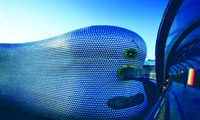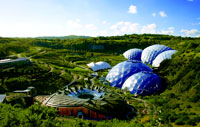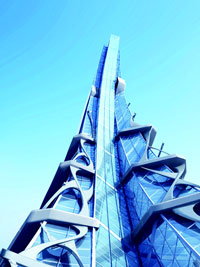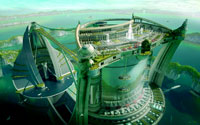ARCHITECTURA
The Future of Building, Biomimicry and Architecture
by - Scott Nelson, Naturalwalls, USA
“Nature is not a place to visit. It is home.” Gary Snyder
There is a very important and necessary shift happening in the world of architecture and design. We are waking up! Awakening to the fact that we are part of the larger ecosystem of the earth and that our creations can both injure and heal the bodies and landscapes that we call home.
|
We have been so enthralled with the powers of human ingenuity that we’ve made things just because we can, like adolescents testing every possibility, and just as a child grows to become a member of a greater family, the human community is growing towards a state of wisdom which considers not just what it can make but why.
Nowhere is this shift more important than in our architecture. The age old need for shelter is the most basic impetus for the human drive to build, but our structures have become so much more than shelter as humanity has evolved. Our buildings express volumes about our culture, ourselves, our beliefs and what we value, individually and collectively. They have become statements of status and taste, repositories of wealth and symbols of security. |


|
This accumulation of meaning has come to obscure the simple fact that buildings exist to shelter and nurture human beings and human beings live in physical bodies that arise from the ground of nature.
In the modern age, with all its technological advances, we have sought domination and escape from the vicissitudes of nature through the development of ever more sophisticated techniques and materials. The primary goal has been protection from the elements that threaten us. The result of this, while positive in some ways (few people in “developed” countries die of exposure anymore), has been to separate us from nature to such a degree that we spend most of our time surrounded by synthetic environments that offer little to “the soft animal of your body” as poet Mary Oliver puts it.
| We long to connect with the textures, colors, and patterns of the natural world because it is where we come from. The nature calendar above our desk at the office and the view out the car window on our drive home is about all the connection that many of us get these days, and yet still the longing is there. We try to meet this primal need for nature by going on vacations once or twice a year, but this is not nearly enough. As Gary Snyder reminds us, nature is our home, not just a place to visit once in awhile. It’s |
 |
no wonder that we often feel disconnected in our everyday environments.
Beyond the effect of all this on our bodies and minds, the effect on the earth itself has been catastrophic. The growth of our cities often resembles that of cancer cells that are destroying the life of their host. We use massive amounts of energy constructing and conditioning our buildings and then bury the scrap in ever expanding landfills. For most of the last century our building methods have not been integrated into the cycles of decay and renewal that are so essential to the health of the ecosystem. Thus, we have created a continual stream of waste for which the other species of the earth have no use. No system that is losing energy or mass from its cycle can survive for long as we all learned in high school physics. This cannot continue.
|
So what is to be done? Build with nature instead of over and against it. Let its ways inform our technologies. This is not a call to suppress our creativity but to make it beautiful. We can begin by considering the relationship of the parts to the whole and the ways in which our buildings can nourish the people within them and the earth upon which they stand.
The growing field of Biomimicry is a promising sign for the future of the human race. The basic premise is that we can learn from and “mimic” structures, materials, and systems that we observe in nature to solve design problems. It would make sense that there is deep wisdom embedded in these things that have developed over millions of years, in the way that a beetle’s shell collects water and a termite mound’s structure creates a cooling effect.
|
 |
Using the principles of Biomimicry, a building can be thought of as a living cell among other living cells that, all together, create a larger community. Let’s start with the cellular membrane: just as a living cell needs a boundary to contain and protect the life happening within it, a house needs walls. Our modern building systems have forgotten the other aspect of a cell wall that is equally important. Cell walls are semi-permeable membranes unlike the walls of most of our houses which are “shrink wrapped” with paint and stucco. The life energy of a cell dissipates without a cellular membrane, likewise, it will die if its cell wall doesn’t allow for selective interaction with its environment. You may point out that we have windows and doors for this but the fact is that we usually keep them closed and when we do open them they are not selective and allow in any pollutants that happen to be floating on the breeze.
| If we use the wisdom of semi-permeable cellular membranes to construct our houses we might consider the importance of wall systems that interact with the elements by allowing the transfer of water vapor into and out of our buildings. This mitigates the possibility of mold growth within the wall structure and improves the livability of the interior spaces by regulating humidity. Wall systems that incorporate natural plaster materials such as clay |
 |
and limestone are a simple, time proven way to create this effect. The adobe houses of the American Southwest are known for their ability to stay cool in the summer and warm in the winter.This is due to both their thermal mass, which retains and releases the energy of the earth and sun, and the semi-permeable nature of the earthen wall materials that maintains a consistent interior humidity. Houses that trap humidity (rather than regulate it) usually stay hot on hot days and cold on cold days. Try wearing a plastic rain suit on a hot (or cold) day to prove this point.
We might also consider that living cells are dependent upon the greater organism of which they are a part just as our homes and work places are dependent upon the water, air, and soil around them. Cells that do harm to the tissue in which they live will not thrive or survive for long. This is the predicament in which we find ourselves today. Cut off from the health and beauty of our natural home by the very houses that we have built for ourselves, we are sickened and starving for some contact with deep beauty and the mystery that sustains us.
A simple, yet profound solution to this sorry state of affairs is to surround ourselves once again with nature, not just on vacation, but in our very homes and offices. This doesn’t only mean hanging pretty pictures on the walls or putting a bouquet on the table but creating architecture whose very materials and forms illicit the same response in us as that mountain stream we sat by last summer or the meadows of our childhood that hummed with life and good energy. Let’s invest in ways to make natural building efficient, safe, and cost effective. Let’s turn our ingenuity and powers of imagination towards a global community that values simplicity and health.
There are many who are already giving their lives to this vision, but it’s going to require all of us to make it reality. It’s the birthright of every human being to live in communion with nature. Let’s start building.
Scott Nelson
Naturalwalls was founded in 1997 by Scott Nelson after a tour of Europe where he was inspired by the natural materials that are used in traditional and modern buildings. “I began to explore the best ways to bring the warmth of those buildings to the design and construction processes that we are familiar with here in the states.”
“During that process of exploration I discovered that those surfaces were often created with limestone and clay plasters. I researched the old recipes and realized that these materials could be directly incorporated into our contemporary buildings in place of our standard petrochemical based paints and stuccos.”
|
 |
“Now, 14 years later, I have been privileged to work with many great clients on beautiful projects. I’m still just as inspired by the feel of a clay wall or the way the light plays across a limestone surface, as I was when I walked down those alleys in Paris and Rome.”
Scott brings his background in the arts to every home, store, or office that he shapes. The intuitive sense of colour and texture exhibited in his paintings translates directly into the balance of these elements that he is continually striving to achieve for his clients.